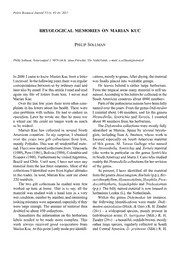
Bryological memories on Marian Kuc. PDF
Preview Bryological memories on Marian Kuc.
Polish Botanical Journal 57(1): 43–44, 2012 BRYOLOGICAL MEMORIES ON MARIAN KUC PHILIP SOLLMAN Philip Sollman, Notarisappel 2, 9076 LB St. Anna Parochie, The Netherlands; e-mail: [email protected] In 2000 I came to know Marian Kuc from a letter cations, mostly to genus. After drying, the material I received. In the following years there was regular was fi nally placed into workable groups. correspondence between us by ordinary mail and He leaves behind a rather large herbarium. later also by email. For this article I read and read From the tropical areas many material is still un- again my fi le of letters from him. I never met named. According to his letters he collected in the Marian Kuc. South American countries about 6000 numbers. Over the last few years there were often com- Parts of the pottiaceous mosses have been fully plaints in his letters about his health. There were named over the years. From the genus Didymodon also problems with ischias. He had to endure an I counted about 140 numbers, and for the genera operation. Later he wrote me that he must use Hennediella, Syntrichia and Tortula, I counted a wheel car. He could no longer work as much about 90 numbers from his herbarium. as he wished. The Didymodon collections were mostly fully Marian Kuc has collected in several South identifi ed in Murcia, Spain by several bryolo- American countries. To my surprise, I obtained gists, including Juan A. Jiménez, whose work is over the years two gift collections from him, focused especially on South American material mainly Pottiales. This was all unidentifi ed mate- of this genus, M. Teresa Gallego who named rial. I have now named collections from: Venezuela the Hennediella, Syntrichia and Tortula material (1980), Peru (1981), Bolivia (1984), Colombia and (she works in particular on the genus Syntrichia Ecuador (1988). Furthermore he visited Argentina, in South America) and María J. Cano who studied Brazil and Chile. Until now, I have not seen any mainly the Hennediella collections for her revision material from the last three countries. Most of the of the genus. collections I identifi ed were from higher altitudes At present, I have identifi ed all the material in the Andes. In total, Marian Kuc sent me about from the genera Anoectangium, Barbula (p.p.), Bry- 220 numbers. oerythrophyllum, Hymenostylium, Hyophila, Pseu- The two gift collections he mailed were fi rst dosymblepharis, Scopelophila and Trichostomum worked up here at home. That is to say, all the (p.p.). The fully named material is now housed in material was studied with a hand lens in a very herbarium Leiden (L), the Netherlands. wet condition, number by number, and interesting Within the genus Didymodon for instance, looking mixtures were separated, especially if they the following identifi cations were made: Didy- were large enough. The amount of material then modon australasiae (Hook. & Grev.) R. H. Zander doubled to about 450 collections. (26×) – a widespread species, mainly present in Sometimes the information on the herbarium (sub)tropical areas; D. laevigatus (Mitt.) R. H. labels needed to be made more complete. This Zander (20×) – a beautiful, reddish-brown, mostly work always received good cooperation from rather large species, regularly collected in South Marian Kuc. At this point I only made pre-identifi - and Central America; D. pruinosus (Mitt.) R. H. 44 POLISH BOTANICAL JOURNAL 57(1). 2012 Fig. 1. Example of original Dr. Marian Kuc’s herbarium label. Zander (8×) – a rather rare species from South this. This material is still not fully named. They America, which is easily overlooked; D. minus- are also present in herbarium Leiden (L). culus (R. S. W illiams) R. H. Zander (5×) – another His herbarium has been evaluated by several tiny species and also easily missed; D. patagon- people to be valuable, especially the (tiny) Didy- icus (Mitt.) Broth. (4×), D. humboldtii (Herzog) modon material. The majority of his herbarium E. H. Hegew. & P. D. Hegew. (1×) and Didy- will be housed in Kraków (Poland), herbarium modon sp. (5×). KRAM. Marian was often very keen, in his letters, to know, if there were ‘new species for science’ ACKNOWLEDGMENTS: I wish to thank María J. Cano, present among his collections. The Didymodon sp. M. Teresa Gallego, Juan. A. Jiménez (all Murcia, Spain) material mentioned above could be a candidate for for their willingness to identify pottiaceous material. Received 17 December 2011
